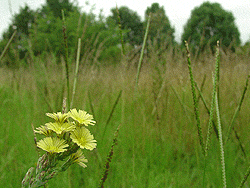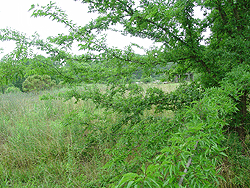Black Belt Prairies
 The Coastal Plain includes an interesting region of soil called the Black Belt, a narrow strip of land about 30 miles wide running in an arc 300 miles long from northeast Mississippi through the middle of Alabama. This region is comprised of sedimentary soil formed at the edge of what was once the ocean boundary. The chalky material of this area, known as Selma chalk, is very alkaline while other areas covered by deposits of clay, are very acidic. Fossils of marine shells can be found in this area where a muddy calcareous “ooze” washed in and settled to the sea bottom in the Cretaceous period about 70 million years ago.
The Coastal Plain includes an interesting region of soil called the Black Belt, a narrow strip of land about 30 miles wide running in an arc 300 miles long from northeast Mississippi through the middle of Alabama. This region is comprised of sedimentary soil formed at the edge of what was once the ocean boundary. The chalky material of this area, known as Selma chalk, is very alkaline while other areas covered by deposits of clay, are very acidic. Fossils of marine shells can be found in this area where a muddy calcareous “ooze” washed in and settled to the sea bottom in the Cretaceous period about 70 million years ago.
 The soil in the Black Belt is very rich but quite alkaline. These soils also contain a considerable amount of montmorillonite clay that shrinks and swells as the soil moisture changes. Only trees that can tolerate these conditions grow here. Hickory, ash, mulberry, black walnut, elm, locust, sassafras, dogwood, poplar, cherry, persimmon, ironwood and black and post oak are some of the trees that will tolerate the alkaline soils. Pine trees are scarce here and almost 10 percent of the land area is covered in treeless prairies. (H. Taylor Rankin, Black Belt Prairie, Montgomery County, Alabama, and Vicinity, Bulletin 454, Agricultural Experiment Station, Auburn University, AL Feb. 1974).
The soil in the Black Belt is very rich but quite alkaline. These soils also contain a considerable amount of montmorillonite clay that shrinks and swells as the soil moisture changes. Only trees that can tolerate these conditions grow here. Hickory, ash, mulberry, black walnut, elm, locust, sassafras, dogwood, poplar, cherry, persimmon, ironwood and black and post oak are some of the trees that will tolerate the alkaline soils. Pine trees are scarce here and almost 10 percent of the land area is covered in treeless prairies. (H. Taylor Rankin, Black Belt Prairie, Montgomery County, Alabama, and Vicinity, Bulletin 454, Agricultural Experiment Station, Auburn University, AL Feb. 1974).
